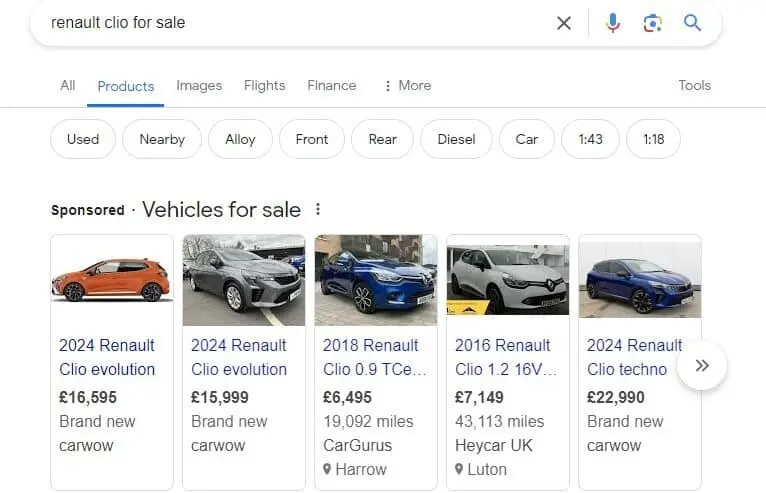Can marketplaces be increasing your ad costs?
Google Vehicle Ads (GVAs) have recently been launched in the UK, promising a new and powerful way for car dealerships to reach potential buyers through Google’s expansive network. These ads are integrated into Google Search results, displaying detailed information about vehicles, including images, prices, and key features, directly to users searching for specific cars. Here’s a closer look at what GVAs are, how they function, and why the use of GVAs by aggregators (like this from Motors) could be detrimental to car dealers.
These ads feature comprehensive details about vehicles, such as make, model, price, and mileage, making it easy for users to see relevant information at a glance. When users click these ads, they are typically taken to a Vehicle Details Page (VDP) to learn more or take further actions like booking a test drive.

How Do GVAs Work?
- Cost-Per-Click Model: Advertisers pay only when a user clicks on their ad. This cost is determined through an auction system where factors like ad quality and bid amount come into play.
- Performance Max Campaigns: GVAs are often run as part of Google’s Performance Max campaigns, which leverage machine learning to optimize ad placement and bidding across multiple Google platforms.
- Automated Targeting: Google’s algorithms use detailed information from the dealership’s inventory feed to match ads with relevant user searches, ensuring high visibility and engagement.
The Role of Aggregators
Many used car advert aggregators have begun offering GVAs as a service to their car advertiser customers. These aggregators create and manage GVA campaigns, directing clicks to their websites rather than the dealerships. While this might seem beneficial in providing broader exposure, it introduces several significant challenges for car dealers.
How Aggregators’ Use of GVAs Can Be Detrimental to Dealers
- Traffic Diversion and Competition:
- Aggregators running GVAs can compete with dealers’ GVA campaigns, driving up costs and diluting the effectiveness of both campaigns. This internal competition can lead to higher cost-per-click rates and less efficient use of advertising budgets.
- Dealers might find their direct GVAs competing against aggregator GVAs, leading to a scenario where they pay more without necessarily gaining additional unique visitors.
- Impact on Brand and Customer Relationship:
- When clicks from GVAs lead to the aggregator’s site instead of the dealer’s, the dealership loses direct interaction with potential customers. This diminishes the dealership’s ability to build brand loyalty and trust.
- The dealer misses out on collecting valuable data about user behaviour and preferences, which is crucial for refining marketing strategies and improving customer experience.
- Challenges in Data and Conversion Tracking:
- Accurate tracking of conversions becomes challenging when initial interactions happen on the aggregator’s site. This complicates the measurement of campaign performance and the assessment of return on investment (ROI).
- Dealers miss out on detailed insights into user interactions on their sites, hindering their ability to optimise their websites and ad campaigns effectively.
Strategic Considerations for Dealers
- Coordination and Exclusivity: Dealers should consider negotiating terms with aggregators to avoid direct competition. Exclusivity agreements where only one party runs GVAs for specific vehicles can prevent unnecessary bidding wars.
- Data Sharing: Ensuring aggregators provide detailed performance data can help dealers make informed decisions and better optimise their own campaigns.
- Focus on Unique Value Propositions: Dealers can highlight unique selling points and special offers in their direct GVAs that aggregators might not emphasize, ensuring that potential customers see the total value of what the dealership offers.
- Work with your existing ad agency. If they don’t have direct access to your data from your CMS or DMS provider, they can use the Google Vehicles Ads feed provided by Marketcheck.
Conclusion
While GVAs offer a powerful tool for reaching new customers, the involvement of aggregators can complicate matters for car dealers. By understanding these dynamics and taking strategic steps, dealers can better manage their advertising efforts and maintain control over their customer relationships and brand presence.
